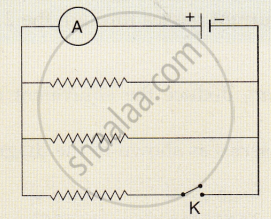Advertisements
Advertisements
प्रश्न
Differentiate between resistances in series and parallel.
उत्तर
| Resistances in Series | Resistances in Parallel | ||
| 1 | In this type of connection, the resistances are connected one after the other such that the same amount of current flows through each resistance. | 1 | In this type of connection, the resistances are connected between two common points such that the potential difference across each resistor is the same. |
| 2 | For n number of resistors connected in series, the effective resistance RS is equal to the sum of the individual resistors. RS = R1 + R2 + R3 + R4+ …… Rn |
2 |
For n number of resistors connected in pparallel, the reciprocal of the effective resistance (Rp) is equal to the sum of the reciprocals of the individual resistances. `1/R_p=1/R_1+1/R_2+..............+1/R_p`
|
| 3 | The effective resistance in series combination is greater than the individual resistances. | 3 | The effective resistance in parallel combination is less than the individual resistances in the combination. |
| 4 | It is used to decrease the current in the circuit. | 4 | It is used to increase the current in the circuit. |
APPEARS IN
संबंधित प्रश्न
Complete the following :-
(b)

Several electric bulbs designed to be used on a 220 V electric supply line are rated 10 W. How many lamps can be connected in parallel with each other across the two wires of 220 V line if the maximum allowable current is 5 A?
A hot plate of an electric oven connected to a 220 V line has two resistance coils A and B, each of 24 Ω resistances, which may be used separately, in series, or in parallel. What are the currents in the three cases?
Show how you would connect two 4 ohm resistors to produce a combined resistance of (a) 2 ohms (b) 8 ohms.
Explain with diagram what is meant by the "series combination" and "parallel combination" of resistances. In which case the resultant resistance is : (i) less, and (ii) more, than either of the individual resistances?
An electric heater which is connected to a 220 V supply line has two resistance coils A and B of 24 Ω resistance each. These coils can be used separately (one at a time), in series or in parallel. Calculate the current drawn when:
(a) only one coil A is used.
(b) coils A and B are used in series.
(c) coils A and B are uses in parallel.
In the diagram shown below, the cell and the ammeter both have negligible resistance. The resistor are identical.
Two resistances when connected in parallel give resultant value of 2 ohm; when connected in series the value becomes 9 ohm. Calculate the value of each resistance.
How will you connect three resistors of resistances 2 Ω, 3 Ω, and 6 Ω to obtain a total resistance of 4 Ω, and 1 Ω?
If current flows through two lamps arranged:
(a) in series,
(b) in parallel,
and the filament of one lamps breaks, what happens to the other lamp? Explain your answer.
Which of the following combinations have the same equivalent resistance between X and Y?
A particular resistance wire has a resistance of 3 ohm per meter. Find the total resistance of three lengths of this wire each 1.5 m long, joined in parallel.
Explain, why is the p.d. between the terminals of a storage battery less when it is supplying current than when it is on open circuit. A battery of e.m.f. 10 volts and internal resistance 2.5 ohms has two resistances of 50 ohms each connected to it. Calculate the power dissipated in each resistance
(a) When they are in series,
(b) When they are in parallel.
In each case calculate the power dissipated in the battery.
A particular resistance wire has a resistance of 3 ohm per meter. Find :
The total resistance of three lengths of this wire each 1.5 m long, in parallel.
A coil in the heater consumes power P on passing current. If it is cut into halves and joined in parallel, it will consume power:
Three resistors of 6Ω, 4Ω and 4Ω are connected together so that the total resistance is 8Ω. Draw a diagram to show this arrangement and give reason to justify your answer.
Two V-I graphs A and B for series and parallel combinations of two resistors are as shown. Giving reason state which graph shows (a) series, (b) parallel combination of the resistors.

Four resistors each of resistance 5 Ω are connected in parallel. What is the effective resistance?
A particular resistance wire has a resistance of 3·0 ohm per metre. Find the resistance of 5 m length of a wire of the same material, but with twice the area of cross section.
